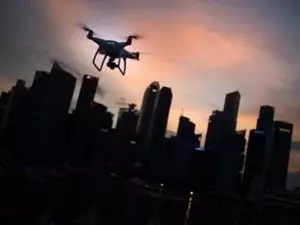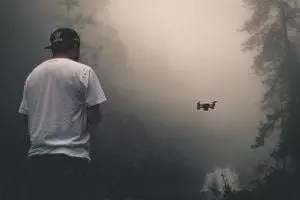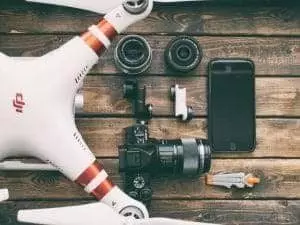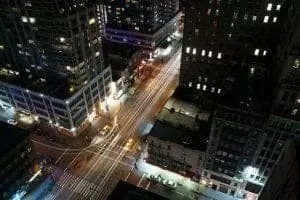Last updated on October 4th, 2023 at 01:12 pm
We’ll cover all the regulations, laws, and equipment checklists, and of course, we’ll give you a few tips on how to get fantastic footage and create better videos with your drone. So, if you want to learn more, feel free to dive in.

Flying a Drone at Night
It seems that there is a lot of confusion when it comes to this topic. So, we decided to make things crisp and clear for everyone. Whether you are just a drone enthusiast or a commercial drone operator, you will learn something from these six things to know about flying a drone at night.
Introduction
- The thrill and excitement of flying a drone during the day can be enhanced when exploring the possibilities of night-time drone flying. This article will delve into flying drones at night, discussing legal considerations, safety precautions, equipment requirements, and techniques to ensure a successful and enjoyable experience.
Legal and Safety Considerations
Understanding the Regulations
- Before embarking on night-time drone flights, you must familiarize yourself with the local aviation regulations and laws about drone operation. Many countries have specific rules governing the use of drones during nighttime, which may include restrictions on flight altitude, mandatory lighting requirements, and the need for special permits or certifications.
Safety Precautions
Flying a drone at night introduces additional risks and challenges compared to daytime flights. To ensure the safety of yourself and others, it is essential to follow some safety precautions, such as:
- Conduct thorough pre-flight checks to ensure the drone is in proper working condition.
- Ensure your drone has appropriate lighting, including navigation lights and anti-collision strobes.
- Maintain a safe distance from obstacles and people to prevent accidents.
- Avoid flying in adverse weather conditions, such as high winds or low visibility.
Importance of Night-time Drone Flying
- Night-time drone flying offers unique aerial photography, videography, and creative exploration opportunities. With the proper techniques and equipment, you can capture stunning images and videos that are not easily achievable during the day. Additionally, flying a drone at night can provide a different perspective and add an element of mystery to your aerial adventures.
Equipment for Night-time Drone Flying
Powerful Strobe Lights
- When flying a drone at night, it is essential to have powerful strobe lights attached to your drone. These lights should provide adequate illumination to help you maintain visual contact with the drone and navigate safely in low-light conditions.
Night Vision Cameras
- Using drones with night vision cameras can significantly enhance your night-time flying experience. These specialized cameras are designed to capture clear and detailed images even in low-light situations, allowing you to explore and document the nocturnal world from a unique perspective.
Pre-flight Preparation
- Prior to flying your drone at night, thorough pre-flight preparation is essential to ensure a safe and successful flight. Some key steps to consider include:
Battery and Power Management
- Make sure your drone’s battery is fully charged and capable of supporting the duration of your flight. Flying at night may require more power due to the additional lighting and camera equipment. It is advisable to carry spare batteries to extend your flight time if needed.
Flight Planning
- Plan your flight route and identify potential obstacles or hazards that may be harder to see at night. Using flight planning apps or software can help you visualize your route and ensure you avoid restricted areas or other airspace conflicts.
Flying Techniques and Tips
Maintaining the Visual Line of Sight
- It is crucial to maintain a clear and unobstructed visual line of sight with your drone throughout the flight. This becomes more challenging at night, as visibility is reduced. Ensure that the drone’s lights are clearly visible, and avoid flying in areas with excessive background light that could obscure your view.
Slow and Smooth Movements
- Flying at a slower pace and employing smooth movements is recommended for night-time drone flights. This allows for better control and reduces the risk of collisions with obstacles or sudden movements that could disorientate the pilot.
Overcoming Challenges
- Flying a drone at night presents several challenges that need to be addressed to ensure a successful flight. Some common challenges include:
Limited Visibility
- Reduced visibility at night requires extra caution. It is essential to rely on your drone’s lighting system and maintain a clear line of sight at all times. Avoid flying in areas with dense fog, heavy rain, or other conditions that further impair visibility.
Navigating in the Dark
- Navigating in the dark can be challenging, especially in unfamiliar areas. Scrolling the flight location during daylight hours is advisable to familiarize yourself with the surroundings and identify any potential obstacles or hazards.
Night-time Photography and Videography
- Night-time drone flights offer unique opportunities for capturing stunning photographs and videos. Here are some tips for night-time photography and videography:
Exposure Settings
- Experiment with different exposure settings to achieve the desired lighting effects. Adjusting ISO, shutter speed, and aperture can help capture well-lit and detailed images or videos.
Light Painting
- Light painting involves using external light sources to illuminate specific subjects or areas during long exposure shots. This technique can add a creative and artistic touch to your night-time aerial photography.
Post-flight Care and Maintenance
- After completing a night-time drone flight, it is crucial to care for your equipment and ensure its longevity properly. Some post-flight care and maintenance steps include:
Battery Management
- Allow your drone’s batteries to cool down before recharging them. Follow the manufacturer’s guidelines for battery maintenance and storage.
Inspection and Cleaning
- Thoroughly inspect your drone for any signs of damage or wear. Clean the drone and its components, including the camera lens, to remove any dirt or debris that may have accumulated during the flight.
1. Yes You Can Fly a Drone at Night
The first thing we want to talk about is a common misconception that people have. And that is that you cannot fly your drone at night. Luckily, as a hobbyist, you do not need a license to do it. However, you must follow some basic safety rules. These rules are determined by the FAA (Federal Aviation Administration) and following them will ensure that you stay away from problems. Here is what they are:
- Flying for hobby or recreational purposes only
- Following a community-based set of safety guidelines
- Flying within visual line-of-sight
- Giving way to manned aircraft.
- Provide prior notification to the airport and air traffic control if you are going to be flying within 5 miles of the airport.
- Flying drones that weigh no more than 55 lbs.
On the other hand, when it comes to commercially flying drones at night, you will have to have a remote pilot airman certificate. With, you can also do it if you have a supervisor with such a certificate. Apply for LAANC to fly at night.

The first thing to know about flying a drone at night is that you can legally fly it without a license, as a hobbyist.
2. Checklist for Flying at Night
There are a few things to pay attention to when preparing your drone for a night flight.
Firstly, make sure that all the batteries are fully charged. This means your drone, your remote, and your cell phone. Remember to bring an SD card and calibrate your drone as soon as you get to the site. However, you need to pay special attention to the way you transport your device and the accompanying equipment. To ensure everything stays in one piece while traveling to the place you are shooting at, take some time to learn how to pack different sorts of electronic devices.
Before you start flying, have the picture or video you want to get in mind. Always have all the shots planned out. The idea is to go from point A to point B and get what you need. Only after that can you allow yourself to fly around for fun.
This way, you are avoiding getting carried away. Just think about how many times you have been in a situation where your battery is dead, and you still do not have the footage you’ve come for. However, if you pay attention to everything from planning your route to preparing a drone and flying it properly, you will not have any problems.
3. The Best Setting for Night Flight
The next of our thing to know about flying a drone at night we want to talk about is the settings.
Besides obligatory calibrating, we would also suggest changing the maximum flight attitude. Although drones are perfectly visible in the nighttime, it is much safer to keep them within 250-350 feet. Additionally, you can set a maximum distance to ensure your drone does not go too far.
Another thing we would like to mention is the Return-to-Home setting. We recommend leaving it on even when you are flying during the day. Just in case you lose a signal, it is good to know that the drone will land right in front of your feet. This is especially important if you are operating a drone in an urban area.

Always prepare your drone for a night flight.
4. Always Scout the Area
This is a thing that is extremely important when flying drones at night. You simply must know your area. You want to be familiar with where you are flying, and the best way to achieve that is to scout it during the day.
Make mental or even written notes of where any hazards could be. Be aware of all the trees, buildings, and power lines that may be in your way. It is hard to see when flying at night, so if you decide to do it, make sure to practice on a spot where you have flown during the day many times.
5. How to Get Amazing Long-Exposure Photos
At the beginning of the article, we promised you some tips on getting fantastic footage, and that time has come. One of the most interesting things about flying drones at night is that you can create incredible long-exposure photography. The stationary lights will remain still, while those in motion will create streaks across the picture.
These shots are not easy to get right, but there are a couple of tricks that can help you. Firstly, you want your ISO value to be way down, at about 100. This will make the picture dark, so increase the shutter speed to brighten it up. Here, you are aiming for a value between 5 to 8 seconds.
If you master this skill, it can be your own game-changer in the real estate marketing process. Just think of the stunning pictures you can create to amaze your drone service clients. Or you can make them for your own houses if you are a real estate agent and a drone enthusiast.

Long-exposure photos can be a great addition to real estate drone service.
6. A well-lit drone is a safe drone.
We consider safety to be the most important thing when flying drones at night. You can never be too cautious, and even if something goes wrong and no one gets hurt, you still can lose the drone, and that is something no one wants. So, to help you maintain a visual line of sight, invest in a good set of drone lights.
When it comes to the onboard red LEDs, you want them to briefly turn off when taking a photo or video. This will ensure that you do not have any of that green or red flares ruining your shot.
And that concludes our list of things to know about flying a drone at night. Remember everything we talked about, and you will stay away from trouble. Fly Safe.
When does “Night” begin, and what kinds of lights should I use?
Part 107 prohibits the operation of an sUAS at night, which is defined as the time between the end of evening civil twilight and the beginning of morning civil twilight, as published in The Air Almanac, converted to local time.
In the continental United States evening civil twilight is the period of sunset until 30 minutes after sunset and morning civil twilight is the period of 30 minutes prior to sunrise until sunrise.
The Air Almanac provides tables that are used to determine sunrise and sunset at various latitudes.
If you are flying in that 30-minute twilight period, your aircraft must be equipped with special anti-collision lights that are capable of being visible for at least 3 miles in all directions.
So, the Part 107 rules state that you can only fly your drone during the day. And that “daylight” is from 30 minutes before official sunrise to 30 minutes after official sunset. And that if you are flying during that 30-minute twilight period you need to have lights that are visible for at least 3 miles.
Night Operations Training
Prior to conducting night operations, the remote PIC and VO must be trained to recognize and overcome visual illusions caused by darkness and understand physiological conditions that may degrade night vision.
The Air Almanac- The Air Almanac
FAA Night Flying- FAA Night Flying https://www.aloft.ai/blog/how-to-apply-for-laanc-at-night-and-during-civil-twilight-in-controlled-airspace/
FAQs
- Q: Is it legal to fly a drone at night?
- A: The legality of night-time drone flying varies by country and region. It is important to familiarize yourself with the local aviation regulations and obtain any necessary permits or certifications.
- Q: What lighting is required for night-time drone flights?
- A: Many countries require drones to have navigation lights and anti-collision strobes for night-time flights. These lights enhance visibility and help prevent collisions.
- Q: Can I use my drone’s built-in camera for night-time photography?
- A: The capabilities of built-in drone cameras vary. For optimal night-time photography, consider using drones equipped with specialized night vision cameras or attach external cameras with better low-light performance.
- Q: Are there any specific flight planning considerations for night-time drone flying?
- A: When planning a night-time drone flight, it is important to identify potential obstacles or hazards that may be harder to see in low-light conditions. Flight planning apps or software can assist in visualizing the flight route and avoiding restricted areas.
- Q: How can I enhance the quality of night-time aerial photographs and videos?
- A: Experiment with exposure settings, such as ISO, shutter speed, and aperture, to achieve the desired lighting effects. Additionally, consider employing light painting techniques to add creative elements to your night-time aerial imagery.
Conclusion
- Flying a drone at night can be an exhilarating and rewarding experience for hobbyists and professionals. However, it is essential to approach night-time drone flying cautiously and adhere to legal regulations and safety guidelines. By understanding the unique challenges and employing the right techniques and equipment, you can unlock a world of creative possibilities and capture stunning imagery in the darkness.
